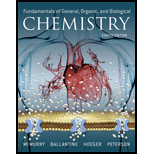
Interpretation:
The charges on the calcium and gluconate ions; either monoatomic or polyatomic ions; the formula for Calcium gluconate to be predicted
Concept Introduction:
Monoatomic ions: Ion consists of exactly one atom.
Polyatomic ions: Ion consists of more than one atom even of same elements or different.
Formation of ions:
Atom possesses equal number of protons and electrons and remains electrically neutral. By gaining (accepting electrons) or losing (donating electrons) one or more electrons, converts the neutral atom into a charged particle called IONS.
Cation: The loss of one or more electrons by a neutral atom leaves the atom positively charged called cation.
Anion: The gain of one or more electrons by a neutral atom leaves the neutral atom negatively charged called anion.
The symbolic representation of ions:
The electrons are reside in the principal quantum number ‘n’; by losing and gaining electron, reduces and increases in the electron count in the electronic configuration of the atom; for a cation adding positive charge as a superscript to the symbol of the element and for the anion adding negative charge as superscript to the symbol of the element.
Want to see the full answer?
Check out a sample textbook solution
Chapter 3 Solutions
Pearson eText Fundamentals of General, Organic, and Biological Chemistry -- Instant Access (Pearson+)
- Identify all of the chirality centers in the structure. The chirality centers are: A В C D `NH E F OH b H Он I J K L M N P Q Rarrow_forwardConsider these compounds: A. PbBr, B. MnS C. Ag,CO3 D. AIPO, Complete the following statements by entering the letter(s) corresponding to the correct compound(s). (If more than one compound fits the description, include all the relevant compounds by writing your answer as a string of characters without punctuation, e.g, ABC.) Without doing any calculations it is possible to determine that magnesium fluoride is more soluble than and magnesium fluoride is less soluble than| It is not possible to determine whether magnesium fluoride is more or less soluble than by simply comparing Kgp values.arrow_forwardThe much-abused drug cocaine is an alkaloid. Alkaloids are noted for their bitter taste, an indication of their basic properties. Cocaine, C17H21O4N, is soluble in water to the extent of 0.17g/100mL solution, and a saturated solution has a pH = 10.08. What is the value of Kb for cocaine?arrow_forward
- Identify the conjugate acids and bases in the following pairs of substances. (CH3)3NH / (CH3)3N *H3NCH2CH,C00 / H2NCH;CH2COO OOCCH,COOH/ 00CCH2CO0arrow_forwardTrans-oleic acid (18:1,D9) has a melting temperature of (44.5C) and cis-oleic acid (18:1,D9) has a melting point of (13.4C). Briefly explain the difference in melting points between the two.arrow_forwardWhat is the molarity of a solution that contains 50.0 g of vitamin B1 hydrochloride (molar mass = 337 g/mol) in 160 mL of solution?arrow_forward
- The ionization of p-nitrophenol is shown below (pKa = 7.0): a. Identify the weak acid and conjugate base. b. At pH 7, what are the relative concentrations of ionized and un-ionized p-nitrophenol? c. If enough concentrated hydrochloric acid is added to a solution of p-nitrophenol to lower the pH from 7 to 5, what will happen to the relative concentrations of the ionized and un-ionized forms? d. Ionized p-nitrophenol has a yellow color, while the un-ionized form is colorless. The yellow color can be measured using a spectrophotometer at 400nm. In order to determine the total amount of p-nitrophenol in a solution, would you perform the spectrophotometer reading at an acidic or basic pH? Clearly explain why? e. A solution of p-nitrophenol at pH 7.95 was found to have an A400 of 0.255 . What is the total concentration (in µM) of p-nitrophenol (ionized plus un-ionized) in the solution? The molar extinction coefficient of p-nitrophenol is 18,500 M-1cm-1 and the pKa is 7.arrow_forwardConsider the following acids and their ionization constant, determine which conjugate base is HCOOH Ka = 1.7 x 10-4 (b) HCN Ka = 4.9 x 10-10arrow_forwardFerrous sulfate is one dietary supplement used to treat iron-deficiency anemia. What are the molecular formula and molecular mass of this compound? howmany milligrams of iron are in 250 mg of ferrous sulfate?arrow_forward
- The main constituents in vinegar are water and ethanoic acid (CH3COOH). In order to determine the concentration of acid in homemade vinegar, a student titrated 25 cm3 of 001 M NaOH against the vinegar. The equation for the reaction is: CH3COOH(aq) + NaOH(aq) ® CH3COONa(aq) + H2O(l) The following titration results were obtained: Burette readings (cm3) Rough 1 2 Final burette reading 20.10 38.90 31.40 Initial burette reading 0.10 20.00 12.50 Volume of vinegar used 20.00 18.90 18.90 (a) What volume of vinegar should be used in the calculation? (b) What is the mole ratio of NaOH:CH3COOH? (c) Calculate the number of moles of alkali in 25 cm3 of NaOH solution used. (d) How many moles of acid were used in the titration? (e) Calculate the…arrow_forwardGive the isoelectric points of following 2 tripeptides DRI and RID.arrow_forwardEthylene glycol, the main ingredient in antifreeze, contains 38.7% carbon, 9.7% hydrogen and 51.6 % oxygen. Calculate the empirical and molecular formulas for ethylene glycol. Given the molar mass is approximately 60 g/mol. A) Empirical formula: B)Molecular formula: Explain how you obtained the Molecular formula (b)?arrow_forward
